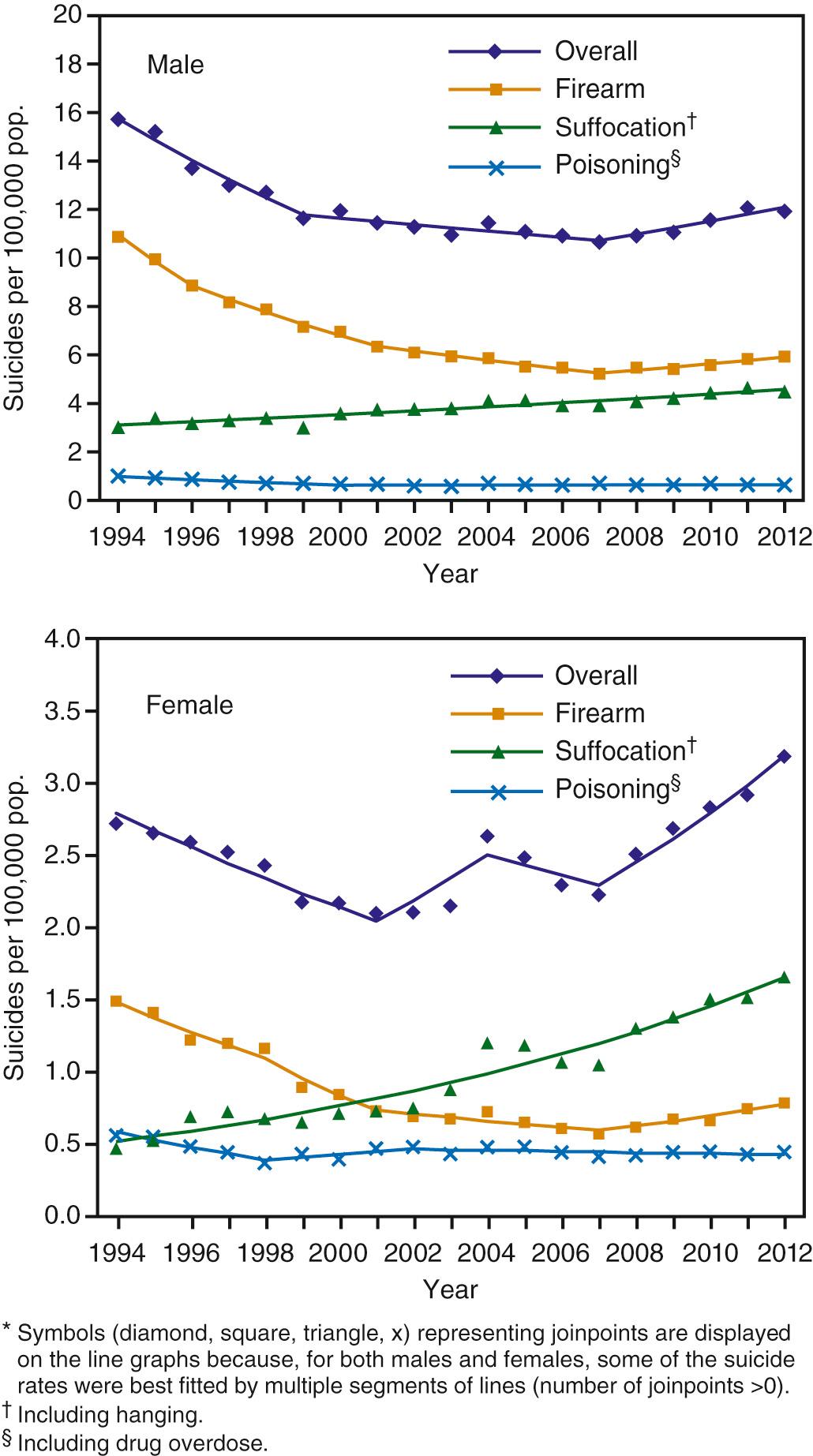Physical Address
304 North Cardinal St.
Dorchester Center, MA 02124
Youth suicide is a major public health problem. In 2014 for all youth between ages 10 and 19 yr in the United States, suicide was the 2nd leading cause of death, with approximately 5,500 lives lost each year. The suicide rate for youth age 15-19 yr was 9.8 per 100,000 persons (14.2 for males, 5.1 for females), while the rate for youth age 10-14 yr was 2.0/100,000 (2.4 for males, 1.6 for females). There are numerous psychiatric, social, cultural, and environmental risk factors for suicidal behavior, and knowledge of these risk factors can facilitate identification of youths at highest risk ( Fig. 40.1 ).
Based on the 2015 Youth Risk Behavior Survey, almost one third of 9th through 12th grade students in the United States felt so sad or hopeless almost every day for ≥2 wk in a row during the previous year that they stopped doing usual activities. During that same period, 18% of the students reported that they had seriously considered attempting suicide, and 9% reported that they had actually attempted suicide one or more times. A suicide attempt in the previous year that resulted in an injury, poisoning, or overdose that had to be treated by a physician or nurse was reported by 3% of students.
It is estimated that for every completed youth suicide, as many as 200 suicide attempts are made. Poisoning, suffocation, and firearms are the most common causes of suicide, whereas ingestion of medication is the most common method of attempted suicide ( Fig. 40.2 ). The 15-19 yr old age-group is the most likely to intentionally harm themselves by ingestion, receive treatment in the emergency department (ED), and survive. Attempts are more common in adolescent females than males (approximately 3 : 1-4 : 1) and in Hispanic females than their non-Hispanic counterparts. Gay, lesbian, bisexual, transgender, and bullied youths also have disproportionately high rates of suicide attempts. Attempters who have made prior suicide attempts, who used a method other than ingestion, who have a plan (nonimpulsive), who have no regret, and who still want to die are at increased risk for completed suicide.

In the United States, completed suicide is very rare before age 10. Rates of completed suicide increase steadily across adolescence into young adulthood, peaking in the early 20s. The male:female ratio for completed suicide rises with age from 3 : 1 in children to approximately 4 : 1 in 15-24 yr olds, and to >6 : 1 among 20-24 yr olds.
In 2015 among 10-19 yr olds, the highest suicide rates, 21.8 and 16.6 per 100,000, were among Native American males and females, respectively, followed by white males (10.6/100,000). The groups with the lowest rates were Asian/Pacific Islander females, Hispanic females, and black females (2.4, 2.3, and 1.9/100,000, respectively). Firearms are the most common method used to complete suicide in the United States, accounting for 50% of all suicide deaths in 2015 ( Fig. 40.2 ). The next most prevalent methods are suffocation (27%) and poisoning (15%). Firearms are the most lethal method of suicide completion; the death rate with respect to firearms is approximately 80–90%, whereas the death rate is only 1.5–4% for overdoses. Among males, firearms are the most frequently used method of suicide (55%); among females, poisoning is the most common method (34%).
From 1999 through 2014, the age-adjusted suicide rate in the United States increased 24%, from 10.5 to 13.0/100,000, with the pace of increase greater after 2006. Rates increased for both males and females and for all ages 10-74; the percent increase among females was greatest for those age 10-14, and for males, those age 45-64.
In addition to age, race/ethnicity, and a history of a previous suicide attempt, multiple risk factors predispose youths to suicide (see Fig. 40.1 ).
Become a Clinical Tree membership for Full access and enjoy Unlimited articles
If you are a member. Log in here